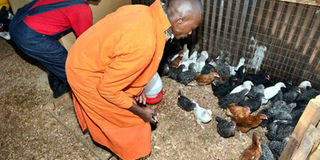Diary of a Poultry Farmer: Your most burning questions answered

An employee of Kienyeji Kenya Ltd attends to some of their chicken in the farm in Njiru. This week, our poultry farmer focusses on responding to farmers poultry farming issues. PHOTO | FRANCIS NDERITU | NATION MEDIA GROUP
What you need to know:
- There are several causes of lameness (weakness/paralysis) in chicken.
- There are about 22 million indigenous chickens in Kenya (Kalro) and these are kept by 90 per cent of rural communities mainly under free-range system.
- Formulating poultry feeds is both a science and art.
- Fowl pox is a slow-spreading disease of fowls and turkeys caused by avian pox virus, which has no known treatment.
I’m a teacher of agriculture at Sirua Aulo High School in Kilgoris. My students and I are avid readers of your diary. We wish to start keeping poultry to demonstrate it can be a profitable alternative to rearing cattle in pastoral communities. What advice would you give us?
Mokua Nduko, Trans Mara
The best place to start is to develop a business plan which covers most aspects like disease control, production and marketing, value proposition, vision and mission.
Please refer to Seeds of Gold (Feb 4 and 11). Second, the plan is just a guide to ensure the risks you take do not outweigh the benefits and it doesn’t have to be perfect. Start small and be ready to learn as you go along.
***
My chickens have weak legs and are just lying down. What is wrong?
Immaculate Kamau
There are several causes of lameness (weakness/paralysis) in chicken.
These include diseases caused by viruses (viral arthritis and Marek’s disease) and bacteria (mycoplasama and staphylococcus). There are also nutritional conditions like rickets and cage layer fatigue syndrome.
Please get in touch with a vet near you.
***
I read your articles passionately and as an aspiring poultry farmer in Botswana, I find them insightful.
Collen Modise, Botswana
Thank you for the support and keep reading. Poultry farming is one of the most lucrative agribusiness globally.
In 2015, out of the Kenya’s $70 billion national wealth, poultry contributed a total $6.3 billion (30 per cent) according to Food and Agriculture Organisation.
***
You’re doing a terrific job. Please share some information about Kienyeji poultry farming.
Robert Mwaniki, ENT Surgeon, Nairobi
There are about 22 million indigenous chickens in Kenya (Kalro) and these are kept by 90 per cent of rural communities mainly under free-range system.
Although hardy, productivity of indigenous chicken is normally low depending on the genotype. These birds also have poor feed conversion efficiency.
Therefore, consider rearing the improved indigenous varieties like Kari Kienyeji, Kenbro or Kuroiler. These improved birds grow faster, weigh more and lay about 200 eggs a year if managed well.
***
Please share information on formulating poultry feeds for broilers.
Nikita Kendi Kinyua, Meru
Formulating poultry feeds is both a science and art. Chicken, just like humans, require a balanced diet comprising carbs (energy source), proteins (growth and development), vitamins and minerals for optimum growth.
You also need to learn to select the material and mix ingredients in the right ratios.
***
I keep 100 three-month-old Kienyeji chickens but the cost of commercial feeds is just unbearable. I started formulating my own feeds despite limited knowledge. I mix 50kg maize germ with 1kg of fishmeal, 1kg sunflower cake, 1kg cotton seed and 1kg soya.
Paul
Your choice of raw materials is weighted towards carbs (energy) at the expense of proteins, minerals and vitamins. You need to learn to select the material and mix ingredients in the right ratios.
***
I developed interest in poultry farming from my father who had started the venture as a hobby. He was busy with other things and later abandoned the project. The chicken pen became dirty and soon, the birds started dying one by one. I wish to revive the project before joining university. Where do I start?
Anthony Santos
First, you need to determine the scale of production (small, medium or large) and the start-up capital. Second, you need to determine the market for your products.
Third, to avoid previous mistakes, you’ll need to ensure that farm biosecurity (hygiene) measures and other disease control practices such as routine vaccination are put in place.
Lastly, factor in the cost of feeds especially if you plan intensive management.
***
My chickens are severely infected with fowl pox. Advise.
Francis Kageche, Ngong
Fowl pox is a slow-spreading disease of fowls and turkeys caused by avian pox virus, which has no known treatment. Vaccination offers the best protection (Seeds of Gold, August 5).
Get in touch with a vet near you.
***
I have been reading your inspirational articles for quite some time. Africa needs agriculture to survive but I wonder if we have strong institutions to develop the sector to its full potential.
Gitahi Kariuki
I agree that strong policy, legislative, institutional, financial and human resources capacity reforms are the key to transform the sector. Thank you and keep reading.
***
How can I get infectious coryza vaccine for my two-week-old chicks.
Oyuga Joseph, Busia
Please get in touch with Dr Ngugi of Murphy Chemicals on 0722785731.
***
I’m looking for mature layers that are about to start laying eggs, five to six months old.
Joseph Gichure, Ruai
I don’t think it’s a good idea at all to buy mature layers unless you’re sure of their age, previous health status, feeding regimen, light management, disease control and vaccination. The value for money may also be low.
***
Your article on July 29 indicated that to get more eggs, layers should be exposed to more light hours.
Jack Gitonga, Thika
Yes, light management will determine four things, namely the age at which the hens start laying eggs, the number of eggs, the size and consistency of laying throughout life.





